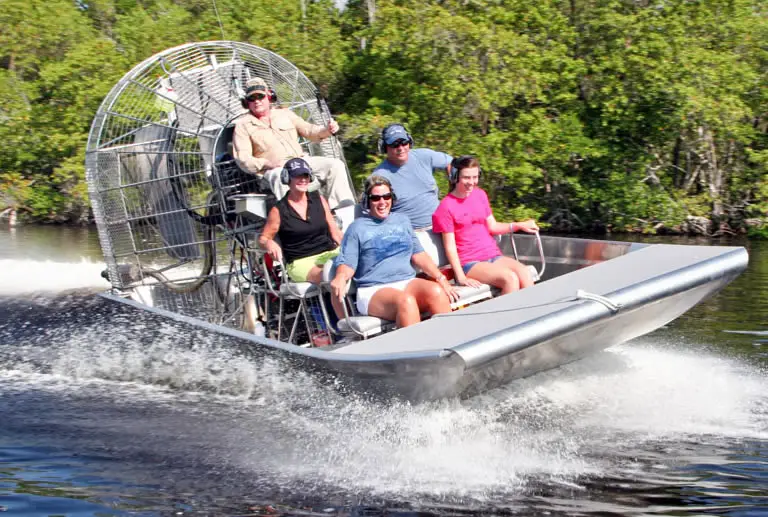Contents
- What Exactly Is This Boat With A Giant Fan?
- The versatility of the modern airboat – what airboats are used for
- How an airboat is different from other boats & how it works
- Other names for an airboat
- History of the airboat
- The most well-known use for the airboat – the swamp boat tour
- What an airboat ride entails
- Pros and cons of airboats
- The new craze surrounding the mini airboat
What Exactly Is This Boat With A Giant Fan?
What is an airboat and ow does it work?
An airboat is a flat-bottomed boat used mostly on inland shallow waters or on large bodies of ice.
It is propelled by a large fan at the back of the boat that is fitted with an airplane styled propeller.
The fan is powered by either an airplane engine or road vehicle motor.
The versatility of the modern airboat – what airboats are used for
Airboats are used most effectively in shallow calm waters.
They are also a highly effective means of transportation on solid ice.
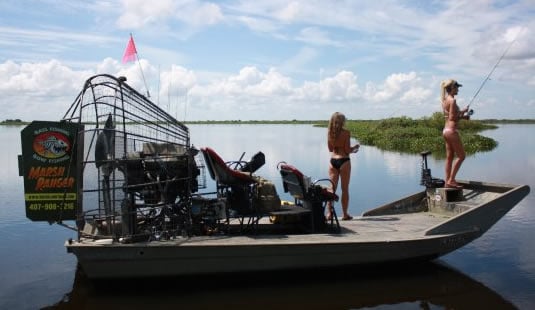
They can be found on rivers, lakes, marshes and iced-areas all across the world.
Although airboats were first used in Canada (and are still used there today) most people associate them with the Gulf States of the USA especially in Florida and Louisiana.
However airboats are popular in almost all areas of the USA and can be found in use worldwide.
They are also very popular in areas that encounter long periods where water bodies freeze into solid ice such as Siberia and Nebraska.
They can move from ice to water, and vice-versa, very easily.
The unique design of an airboat and its ability to access very shallow waters has proven popular with many military groups across the world.
It was first employed as far back as WWI and as recently as the Iraq War.
The US Coast Guard also maintains airboats as part of its fleet.
Most civilian airboats are used for tourism, fishing and hunting.
What airboats are not good at
An airboat, like other flat-bottomed boats is best suited to calm waters.
Its flat hull design means an airboat is not seaworthy and is therefore unfit to be used in the ocean.
Airboats perform best when used in shallow calm waterways with temperate weather conditions.
How an airboat is different from other boats & how it works
An airboat works in similar ways to other flat bottom boats but with a very key difference in its means of propulsion.
First let’s look at the similarities an airboat has with other flat-bottomed boats..
Like other flat-bottomed boats, such as a Jon boat for example, an airboat has a very shallow draft. This mean the lowest point of the boat sits very close to the waterline unlike boats with deeper drafts.
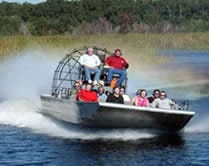 Boats with deeper drafts are preferred for ocean use and usage in challenging water conditions because they offer more stability in choppy waters.
Boats with deeper drafts are preferred for ocean use and usage in challenging water conditions because they offer more stability in choppy waters.
More of the boat is actually in the water.
Deeper draft boats will often also have a keel to help counterbalance the effects of strong waves.
If you want to learn more about the importance of a boat’s draft read the article shallow draft vs deep draft.
An airboat has neither a keel nor a deep draft.
It has a completely flat bottom that sits just below the waterline with no mechanical parts in the water at all. This gives the airboat a very shallow draft.
Think of an airboat as sitting on the water rather than in it.
An easy way to understand this is to view a deep draft boat as sitting deep in the water and to view a flat-bottomed boat, such as an airboat, as sitting on the water.
This is a very simplistic, and not totally accurate, illustration but it should help you understand the differences between these boat types.
A simple explanation of shallow draft and deep draft:
- A deep draft = a boat that sits deeper in the water.
- A shallow draft = a boat that sits higher in the water.
Due to its flat bottom an airboat almost glides over the water offering an exceptionally smooth ride.
They are very comfortable to travel in even at very high speed.
The difference between an airboat and other types of flat bottom boat is in its propulsion.
Where other flat bottom boats use an outboard engine with a propeller in the water or some form of manual propulsion such as oars or a paddle, an airboat uses a fan to force air behind the boat and push the vessel forward (more on that below).
Why an airboat needs a flat bottom and shallow draft
Boats with deeper drafts perform well in deep, rough waters. However, most of them are unable to navigate shallow waters as the bottom of the boat would snag on obstacles or run aground.
On the flip side airboats, like other flat-bottomed vessels, due to their shallow draft can navigate very shallow bodies of water.
This allows them to be used in water bodies that are not accessible to other types of boat such as very shallow rivers, shallow lakes, marshes, swamps etc.
The depth of the water that most flat-bottomed boats can navigate is usually only limited by their use of propulsion.
For instance a Jon boat can traverse waterways only a few inches deep when using a pole to push the boat but will not be able to access such shallow areas if using an outboard motor due to the propeller that lies below the boat.
Airboats do not have this problem.
How an airboat’s fan makes it different from other flat bottom boats
Unlike most other flat-bottomed boats an airboat has no mechanical components below the waterline such as a rudder or propeller because the propeller is situated at the back of the boat.
This gives an airboat an exceptionally shallow draft, while still having a powerful motor to propel it at speed.
A normal boat, or other flat bottom boats (with the exception of a scow or sailing canoe which have sails), will usually be propelled by the dispersal of water at the back of the boat via an outboard motor with the propeller in the water.
Or they can be propelled and steered manually by the use of a paddle or oars which also must be in the water.
However, an airboat’s propeller is situated on the boat and never touches the water.
Instead the propeller uses air to push the boat forward.
At the back of an airboat there is a huge fan that contains an airplane-styled propeller.
This fan forces air behind the boat thus pushing the craft forward.
As there are no mechanical parts underneath the boat, and because it has a flat bottom, airboats are also exceptionally good at traversing solid ice; they simply glide across the ice.
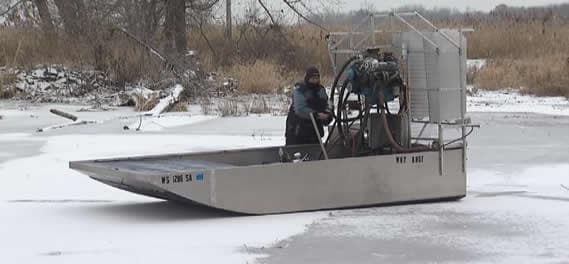
How to turn and stop an airboat
To turn an airboat you must manipulate the stream of air that the fan is generating behind the vessel.
You do this by deflecting the airstream to the right or left via the throttle stick control.
Steering via airflow deflection is achieved through the use of rudders attached to the back of the boat that steer the air pushed out by the fan.
Like all boats, airboats do not have breaks. An airboat is not capable of stopping on a dime nor can it travel in reverse.
Slowing down an airboat requires the driver to reduce the throttle and thus reduce the speed of the boat some time before he/she actually wants the boat to stop.
There is a certain degree of skill involved in turning and stopping an airboat which only comes through practice and experience.
Other names for an airboat
Because airboats are propelled by giant fans at the back of the boat, with no water-based rudder or water-based propulsion, they are often referred to as fanboats or fan boats.
Additionally, because airboats are commonly used in marshy swamp areas they are also known as swamp boats.
History of the airboat
Although airboats are most associated with North America they were not invented in the United States and were not even invented by a North American – contrary to popular opinion.
Who invented the airboat?
The airboat was in fact invented by the Scottish engineer Alexander Graham Bell, who you may remember also invented the telephone, the metal detector and a host of other useful devices.
What’s more, Bell actually built the first airboat in Nova Scotia, Canada in 1905, not in the United States.
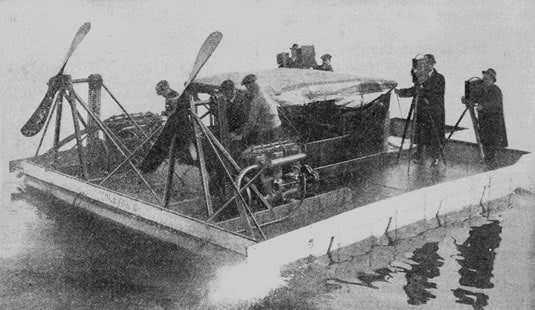
After Alexander Graham Bell invented the airboat in 1905 they were first noticed by the British army. Airboats had such a successful design and worked so well in shallow bodies of water that the British Army began using them in World War I.
It wasn’t until the 1920s that airboats were first introduced to the USA in areas such as Florida, Louisiana and in other Gulf States.
Though they proved to be a great watercraft for fishing and hunting in shallow waters their growth in popularity was relatively slow.
It was not until the 1930s that airboats really took off (excuse the pun) with civilians.
When it came to war though it was not only the British army that deployed airboats in battle.
Even before WWII the Soviet Union’s Red Army was using airboats. They used them because they operate just as well over ice as they do in shallow water (large parts of Russia experience solid ice in the winter and Siberia has constant ice).
With no mechanical parts below the waterline, such as a propeller or rudder for example, and its flat-bottomed hull an airboat can glide smoothly, effortlessly and at high speed over ice.
The US has also enlisted the help of the airboat by deploying it as recently as the Vietnam War and the Iraq War.
Although militaries across the world still utilize them, the majority of modern airboats are used by civilians for tourism, fishing and hunting.
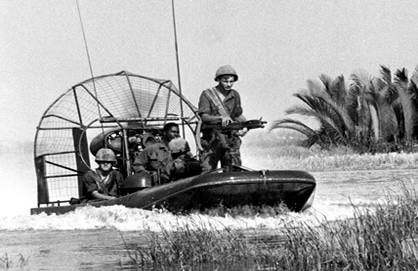
The most well-known use for the airboat – the swamp boat tour
Airboat tours are conducted in areas of natural beauty that contain shallow areas of water that are easily navigated by flat-bottomed airboats.
Airboat tours are very popular in America’s wetland, in the Sunshine State of Florida and in Louisiana.
The Florida Everglades offer a unique diversified ecosystem.
The Everglades are filled with marshy bodies of water that are so shallow in places that only an airboat can access them at speed.
Louisiana offers truly unique swamp tours in inches of water and at speeds up to 35 mph.
These tours are also known as airboat rides.
What an airboat ride entails
What is an airboat ride?
An airboat ride is a high speed journey on an airboat.
Although the most common airboat rides are those offered in Florida in the Everglades and in the swamps of Louisiana you can take an airboat ride on any type of calm shallow waterway.
Though the Florida airboat tours are arguably the most well-known you can take an airboat ride in States all across the USA from The Cajun Airboat Tour in Louisiana to Nebraska’s River Life Tours.
Swamp boat tours are also popular in New Orleans.
Whichever type of airboat ride you take make sure you wear the appropriate clothing.
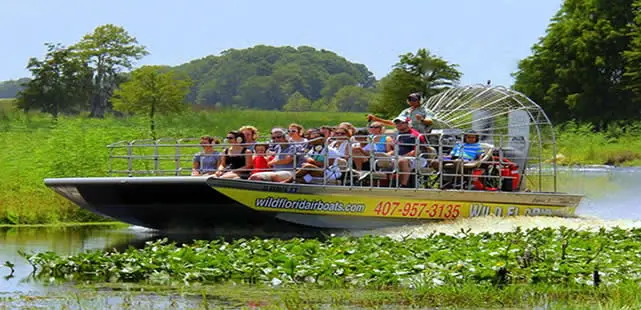
Pros and cons of airboats
Hopefully the above information has shown you the many advantages that an airboat offers and some of it disadvantages.
If you have skipped to this part or need a refresher here is a bullet list of an airboat’s pros and one for its cons.
Pros of an airboat:
- The flat bottom design means an airboat glide on the water offering a very comfortable ride in calm conditions.
- The flat bottom hull and lack of mechanical parts in the water means an airboat can navigate extremely shallow bodies of water even at high speed.
- The fan with its airplane-style propeller and powerful motor means an airboat can travel at very high speed. Some racing airboats can hit speeds of up to 130 mph, though most commercial tourist vessels are limited to about 40 mph (which is still pretty fast).
- A airboat is super fun to ride in.
- Airboats are very fast compared to other watercraft.
- An airboat can access very shallow and narrow waterways and rivers.
- Airboats are great for inland waters.
Cons of an airboat:
- An airboat is not seaworthy. No ocean use for this type of vessel.
- An airboat is unstable in choppy waters and bad weather conditions. They can sink easily.
- Airboats are very noisy.
- An airboat has heavy fuel consumption. (Average of 2 miles per gallon is common).
- Airboats tend to require more maintenance than most other boat types due to the fan.
The new craze surrounding the mini airboat
A mini airboat is a great fun way to enjoy air boating.
A mini airboat is a small single passenger flat bottom boat with a fan on its back.
It is a smaller version of the commercial airboats used for tours.
Many mini airboats are homemade.
Mini airboats are so popular that there is even a Mini Airboat Association based in Elizabethville, PA.
It is open to mini airboat enthusiasts everywhere. It has its own forum which is worth joining if you are interested in this aspect of airboating.

